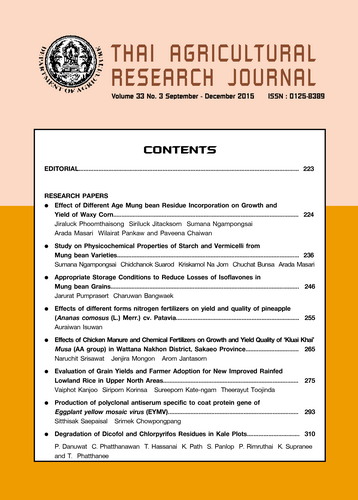Effect of Different Age Mung bean Residue Incorporation on Growth and Yield of Waxy Corn
Keywords:
mung bean residues, incorporation, subsequent cropsAbstract
Legumes residues can be used as a source of nitrogen fertilizer for several crops including maize. The aim of this study was to compare the impact of mung bean ages for incorporation and for yield and quality of waxy corn production. The field experiment was conducted in a sandy loam soil located at Dong Khen Luang, Chai Nat Province during 2012-2013. There were 8 treatments in the present study and they were arranged in RCBD with 4 replications. Four various ages of mung bean plant viz. 35, 45, 65 (first harvesting time) and 75 (second harvesting time) days old were incorporated before being compared to other four chemical fertilizer treatments (0, 10, 20 and 30 kg N/ rai). Waxy corn was grown as a succeeding crop in rainy and dry seasons. Yield of waxy corn ears with and without husk grown in all four treatments of mung bean residues incorporated soil and 10 kg N/rai was not significantly different in both growing seasons. Combined analysis of variance 2 crop seasons revealed that the highest ear with husk yield was found in the treatment of 30 kg N/rai which produced 1,652 kg/rai, but did not differ from those that received 10 and 20 kg N/rai giving 1,394 and 1,567 kg/rai. As for ear without husk yield, the waxy corn grown after fallow and received 20 and 30 kg N/rai had highest yield which produced 1,161 and 1,218 kg/ rai, respectively. Results indicate that incorporation of 65 days old mung bean (after first harvesting) in rainy season and of 45 days old mung bean in dry season can enhance yield of waxy corn.
Downloads
Published
How to Cite
Issue
Section
License
Copyright (c) 2017 วารสารวิชาการเกษตร (Thai Agricultural Research Journal)

This work is licensed under a Creative Commons Attribution-NonCommercial-NoDerivatives 4.0 International License.
Thai Agricultural Research Journal



